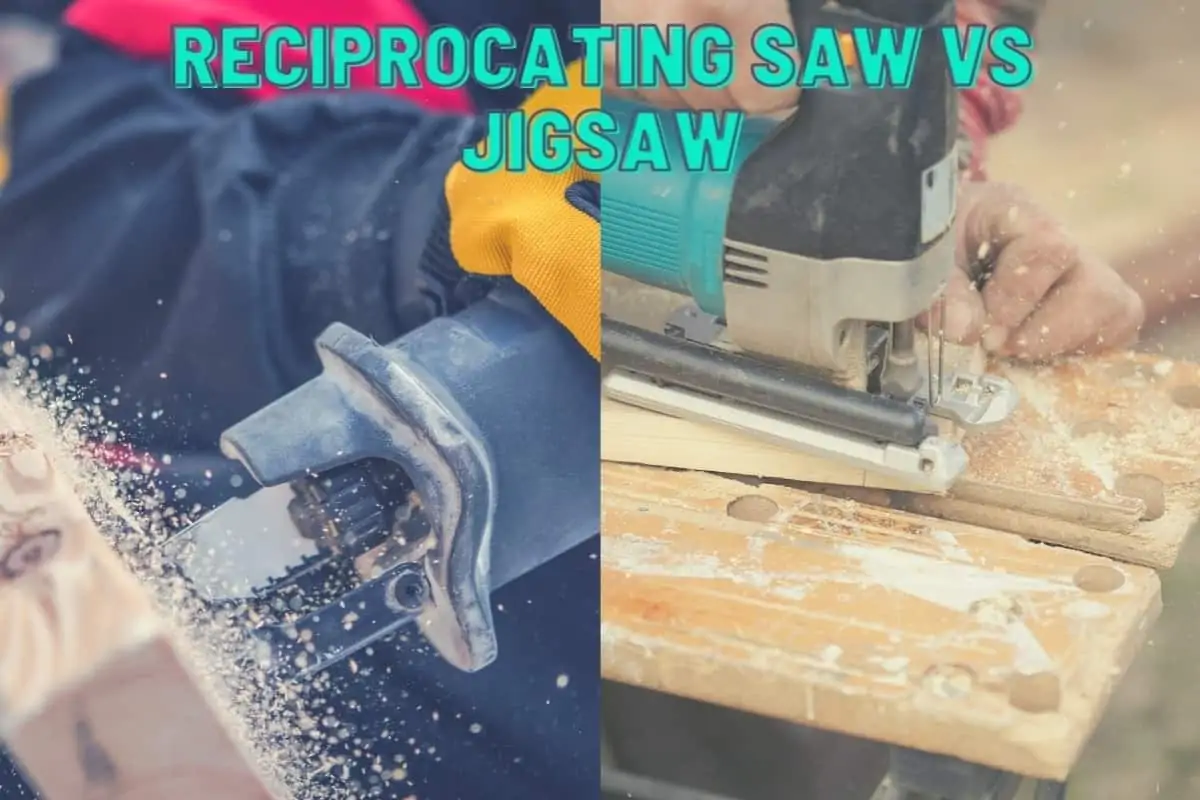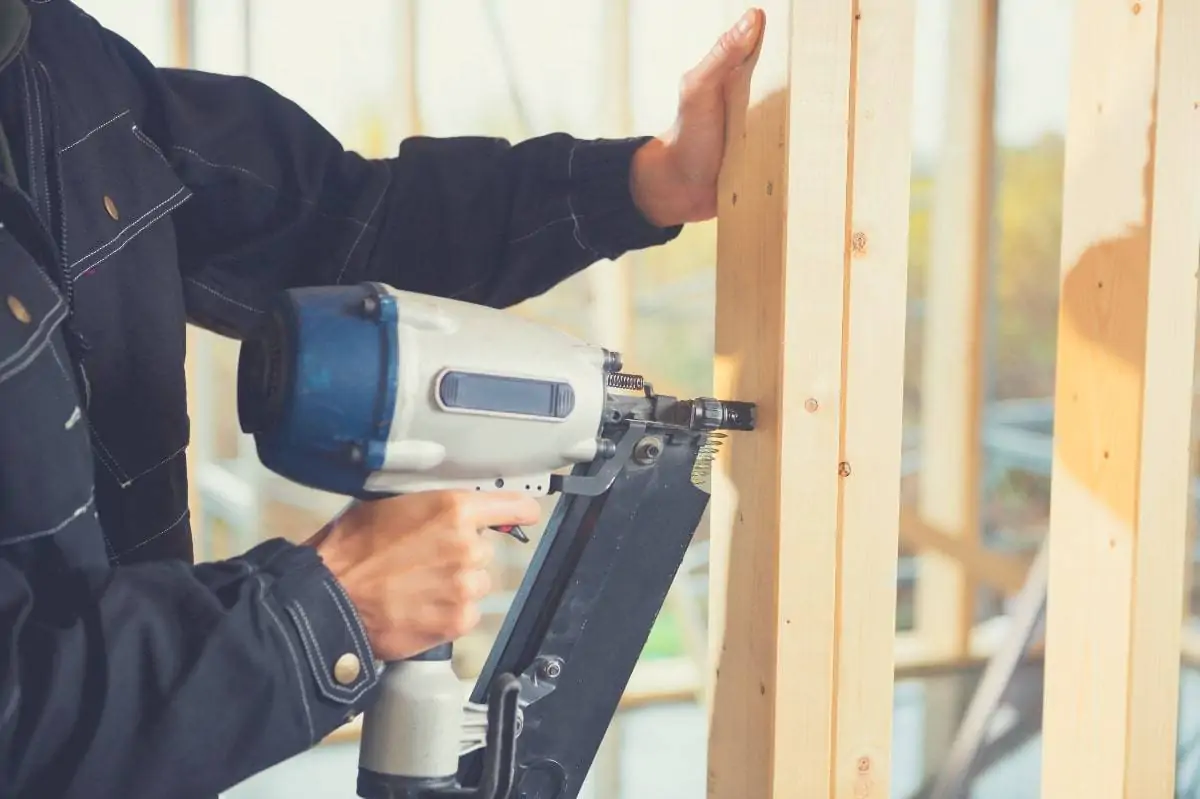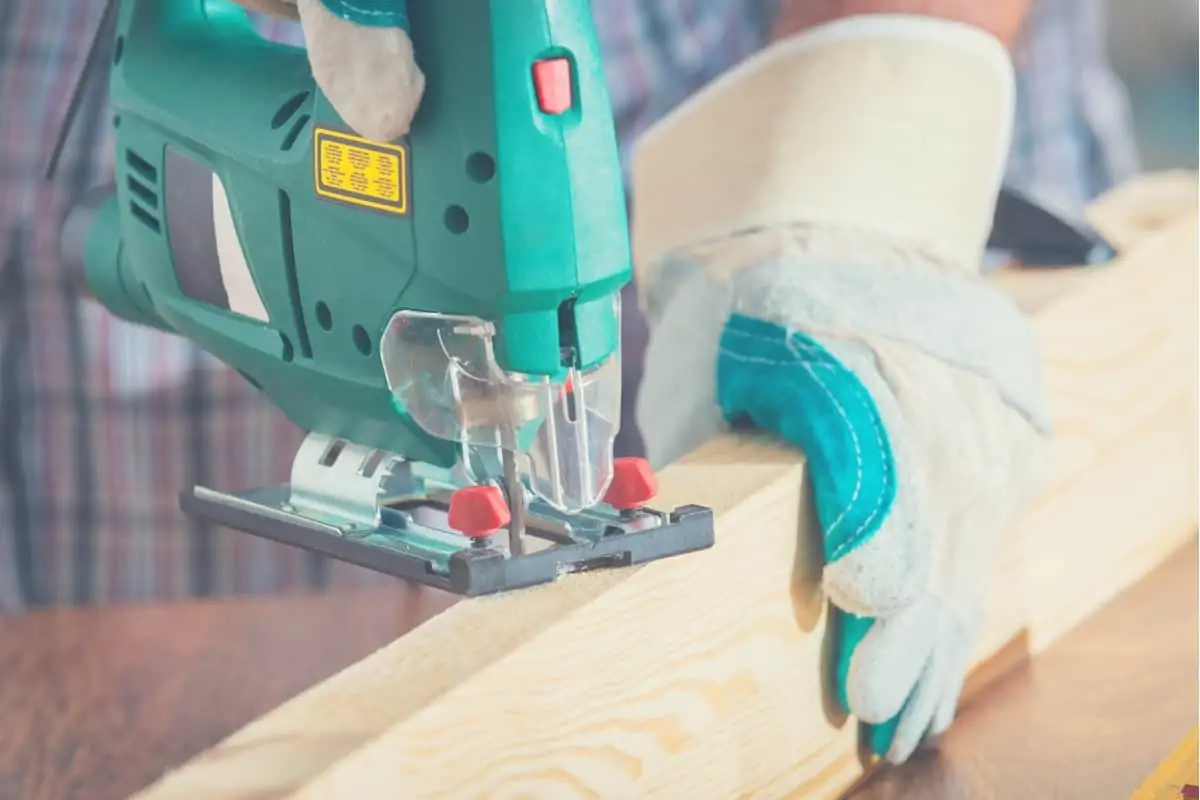If you’ve got some home improvement projects coming up, regularly find yourself cutting up large pieces of plywood, or there’s a demolition project in the offing, you might be pondering between a Reciprocating Saw Vs Jigsaw.
Two worth considering are a reciprocating saw and a jigsaw, but which one is better for your projects?
A jigsaw is a type of reciprocating saw, but you can’t replace one with the other. Likewise, a reciprocating saw is not a jigsaw. There are some differences, and knowing what they are will help you decide whether you’ll find a reciprocating saw vs. a jigsaw most useful.
The similarity between these saws is that they both utilize a reciprocating movement of the blade. However, that doesn’t mean they perform the same functions.
In this article, I will be writing about these disparities, explaining how each saw works and introducing some of the projects and tasks you can use them for.
Let’s take a closer look at each one in turn.
Reciprocating Saw
You’ll find this saw referred to by several different names. Recipro saw, saber saw and Sawzall are just a few examples. It’s a versatile tool, and you can use it to cut through a variety of materials, including wood, masonry, ceramic tile, fiberglass, and metal.
In appearance, it’s similar to a chainsaw but with a shrunken blade and a type of power drill handle.
It’s different from other types of saw because the blade and handle are parallel to each other instead of sticking down at a 90-degree angle. There is a hook on one end of the blade, and it moves back and forth rapidly.
How They Work
The name of this saw explains how it works. It’s a reciprocal saw, which means that the blade moves back and forth rapidly. If you’re cutting things out in the open, it’s one of the best power saws you can buy.
It has several parts: the motor, blade, speed and control system, lock-off switch, and cordless models have a battery.
Some reciprocating saw models use a pendulum/orbital action, and other models have a switch that allows you to switch between motions.
Orbital action refers to the movement of the blade. It moves the blade in a slightly circular motion as the blade moves in and out. This phenomenon allows cuts to be made faster in softer materials and removes chips from the blade’s path.
The blade is on the short side, allowing the saw’s motor to deliver a lot of power and giving it the ability to saw through various metals, even bone, very quickly.
Both corded and cordless models are available, each with its own pros and cons. A corded model will not run out of power, while a cordless model is more mobile.
The type of blade you use will determine the material the saw can cut. To cut pipes, rebar, bolts, and wood, you’ll need bi-metal and high-carbon blades. To cut aluminum, a carbide blade would be better. For more complex and significant cutting requirements, a diamond grit blade is more effective.
Common Uses
Reciprocating saws tend to be used for heavy-duty and rough cuts. It’s not a saw that’s overly accurate, and the design doesn’t lend itself well to precision jobs.
If you’re not too concerned about the finished piece’s aesthetics, a recipro saw comes into its own. Demolition work is an excellent example of what this saw handles very well.
You can use this saw for:
- Cutting through metal, masonry, wood, plywood, plastic, fiberglass, brick, ceramic tiles, and drywall
- Pruning trees and plants
- Cutting window and door frames
How thick a reciprocating saw cuts depends on the blade you use, but in essence it can cut almost any thickness.
It’s a useful tool to have if you regularly undertake electrical or plumbing jobs because of the ease with which it quickly cuts through wood, masonry, and plaster sections. Cutting in high-up places is another situation in which it’s a handy tool to have around.
Accuracy and User-Friendliness
As I’ve already mentioned, this saw is not meant for making delicate and precise cuts. The push-pull motion and high power combine to make this saw unpredictable.
You’ll be disappointed if you’re expecting this saw to make clean cuts. If no finesse is required, You’ll find this saw can tackle most cutting jobs.
In terms of user-friendliness, this workhorse is easy to use, much lighter than a jigsaw, and perfectly suited for demolition work, but don’t forget it can be a potentially dangerous tool to use. Reciprocating saw safety is key to minimizing injuries in the workplace.
Remember that this is not a saw you can use with just one hand. You’ll generally find there are grips at the front and back of the saw so you can hold it securely.
Watch this video for some safety tips.
Cost
The price of this saw will vary, depending on the retailer. Nevertheless, as a general rule of thumb, you can expect to pay a little more compared to a jigsaw.
If your budget is tight and you want a power saw to perform various tasks, a jigsaw might suit you better. Not only is it lower in price, but it can also complete more intricate cuts.
Pros and Cons
This type of saw is popular for many reasons. However, there are also some downsides.
Pros
- Portability: It is compact to store away and can be transported easily, with the cordless model being the most portable.
- Versatility: You can use one to cut most construction material, either vertically or horizontally.
- Safety: The blade is protected and the handle and wires insulated. The rubber coating on the handle means you’re less likely to get blisters.
- Reliability: It can be relied on to perform a range of cutting functions that other saws would struggle with.
Cons
- Inaccurate: It cannot cut complex shapes or accurate curves, and the finish is rather ragged.
Jigsaw
A jigsaw is similar in some ways to a reciprocating saw, but the most noticeable difference is that the blade sticks out from the bottom of the tool at a 90-degree angle. Jigsaw blades are also much thinner and narrower than a recipro saw blade.
The size of the blade lends itself well to more detailed and intricate work. However, it also means that the blade is more likely to break if you push too hard. On a more positive note, the variety of blades is more expansive and allows you to match the blade to the cutting task.
You can use a jigsaw to cut a range of materials such as plastic, wood, and metals, including mild steel or aluminum.
The range of cuts you can make is just as diverse. Use this tool to cut all sorts of intricate designs, curves, plunge cuts, bevel cuts, and straight lines. That being said, it does depend on the jigsaw blade you use.
Other useful features to look for include tool-free blade changing, a dust blower, and a shoe bevel.
How They Work
Jigsaws and reciprocating saws work in the same way. They operate with a pushing and pulling motion and have variable speeds.
There is an advantage to cutting in this way. It means you can use the saw to cut vertically and horizontally.
A motor drives the jigsaw’s narrow blade up and down in a rapid motion. This is known as a reciprocating motion. A set of eccentric gears connects the motor. The axes of this type of gear are off-center.
The gears convert the motor’s rotary motion into the reciprocating vertical movement of the holder of the blade. This action causes the blade to move up and down very quickly.
A jigsaw’s blade usually cuts on the upstroke because the teeth of the blade point upwards. To use the saw, you place the base or shoe against the workpiece. As the blade cuts, it will pull the work against the shoe.
When you’re working on materials with a pre-finished surface, you should use a reverse blade, with teeth pointing downwards, as this reduces the risk of nicking or chipping when you’re cutting.
A dust blower blows air over your workpiece, just above the blade, which stops dust and debris from obscuring the cutting line.
If a jigsaw features a shoe bevel, it means you can angle the saw to cut at different angles. A shoe bevel is a curved shoe along the bottom of the jigsaw that tends to be aluminum or steel.
A jigsaw is more complex in design than a recipro saw and consists of more parts. These include:
- Blade, blade roller guard, and blade guard for increased safety
- Clamp mechanism
- Shoe or footplate
- Handle
- Some more expensive models have a laser guide
- Lock-on button
- on/off switch
- Button to switch to orbital action
It’s possible to alter the speed of most machines with a variable speed dial. With an orbital action function, this feature allows you to control the cut and work with various materials. High speeds are better for wood, while slower speeds are best for metal and plastic.
Size and Weight
Both saws tend to be lighter to use than many other saws. Nonetheless, a jigsaw is usually the heavier of the two, coming in at between six and twelve pounds, on average.
In size, a jigsaw is more layered vertically and compact. Its design also lends itself to being used with one hand. Unlike a reciprocating saw, this saw has no extra grip.
Power, Speed, and Torque
Power, speed, and torque are fundamental features to consider when choosing a saw for your projects.
Power
Jigsaws can be either corded or cordless. Cordless models tend to be less powerful than a corded equivalent. You also have to ensure the battery has a full charge. On the plus side, their portability is hard to match.
It’s worth noting that when you repeatedly recharge batteries and only partially discharge them, they gradually lose usable capacity.
Not all jigsaws have the same power. A jigsaw will have more cutting power when its motor can produce more energy. A low-powered saw will typically have a motor of 5-amps or less. The motor in a better quality saw will be around 6-amps.
When measured in watts, power can range from 350-800 watts. Such a rating will allow you to cut through various materials. A rating of 900 watts or above will make cutting easier and be less of a strain.
Speed
With a jigsaw, you can expect a variable speed function, but not all have one. For those that do, the number of settings can vary considerably.
It’s not an essential feature if you only work with wood, but adjusting the speed is a crucial benefit for materials such as metal. Slow speeds make for a better cut and can also be useful when making curved and intricate cuts.
Torque
Torque is a rating often used when describing power tools, but it’s not one that applies to this type of saw. It is a measure of force through an arc or force produced to turn an object. This means manufacturers commonly use it in reference to circular and band saws and also for drills. In the case of a jigsaw, as no circular motion takes place, it’s not applicable.
For another explanation of torque, you should watch this video.
Energy Efficiency
In terms of energy efficiency, a cordless jigsaw is more energy-efficient than a corded model. If it uses an ENERGY STAR battery charger, it will use around 30% less energy.
Cost
You can expect to pay less for a jigsaw saw. It comes out pretty low in the saw price bracket, compared to other types of saw. Given its versatility, it’s a sensible choice if your budget is limited.
It’s worth considering that prices can vary considerably from retailer to retailer, which means you might find saws that are similar in price.
Frequently Asked Questions
There are a number of questions that people commonly ask when choosing between a reciprocating saw vs. a jigsaw. To help with your decision, here are the answers.
What Can I Use Instead of a Jigsaw?
You use a jigsaw for cutting stenciled designs and curves, but other tools will mimic some if not all of a jigsaw’s function.
A coping saw has a skinny blade and you can use it to cut shapes out of wood with excellent results. The blade is thin, but the tool is flexible enough to cope with stenciling, fretwork, lettering, and other intricate projects.
You can use a reciprocating saw to cut curves and stencils, but the finish will not be exact.
You can use a band saw for big projects, but it’s not as portable as a jigsaw, and you’ll have to move the wood around the table.
To cut a shape into a piece of wood, an option is to use a rotary saw. If you use a jigsaw, you’ll first have to cut a pilot hole. This isn’t necessary with a rotary saw because it uses a spiral blade to cut the pilot hole.
Can a Reciprocating Saw Cut Curves?
If you’re not bothered about a highly finished result, it is possible to cut curves using a reciprocating saw.
Use thinner, flexible, and longer blades, and you’ll be able to do freehand curves, to a certain extent.
How Thick Can a Reciprocating Saw Cut?
A reciprocating saw can cut through just about anything. The only limitation to the cutting thickness is the blade. If you’re going to be cutting through construction timber that may have nails embedded in it, a demolition blade is better. This type of blade is thicker, broader, and less prone to bending.
For cutting metal, it’s better to choose a blade that has fewer teeth. Look for something in the range of 18 TPI. The cut will be less aggressive and more comfortable to control.
There are also blades with tooth configurations and stiffness specifically for this type of work. For cutting tubing and thin metal, use a blade with more teeth, such as 24 TPI.
Longer blades are more effective at cutting wood or metal that’s flush to a surface. The added blade length allows it to flex into a curve, thereby letting you cut away the material as you run the blade along the surface.
Can You Cut 2×4 With a Jigsaw?
Yes, you can. It’s not the best tool for the job, but if you do it slowly, patiently, and with the right set-up, it is possible.
If you need to cut 2×4 with a jigsaw, you must keep flexing and drift to an absolute minimum. You must also keep control of the blade at all times.
For cutting 2×4, a circular saw would be a better choice of cutting tool.
Can a Reciprocating Saw Cut Concrete?
It is possible to cut concrete using a reciprocating saw, but it does have to be a piece that’s thin enough, which is often not the case.
You should never choose to cut concrete. Other more suitable tools include an angle grinder or a circular saw with a diamond blade.
Reciprocating Saw Vs. Jigsaw – So Which is Best For Me?
For each of these saws, there will be a long line of admirers. Which line you choose depends on your needs. Both are ideal for professional and home use.
Jigsaws are better suited for more intricate projects such as cutting complex shapes and carvings. It’s also an excellent tool for remodeling as it can cut through a variety of materials.
Reciprocating saws are more heavy-duty and the go-to tool for demolition and destruction. It’s a powerful tool but not at all precise.
Your decision rests on whether you want to use the tool to create or destroy.
I hope you found my comparisons useful. If you’d like to add something that may benefit others, please add it in the comment section below.



